The action of August 1942 still stirs up emotions among lovers of marine subjects. Victory or defeat? Necessary retreat or shameful betrayal? The operation that saved one of the most valuable colonies in the empire or the operation "M" - like murder? "Pedestal" is not easy to forget.
In the summer of 1941, the Axis powers gained almost total supremacy in the Mediterranean. In this situation, the British tried to keep Malta in their hands at all costs. But it's easier said than done. Each supply convoy for a small island was almost a suicide mission.
Malta, a British colony since 1814, during the Second World War was an extremely important base for the Royal Navy in the Mediterranean Sea. The strategic location of the island, however, exposed it to constant attacks by Italian and German bombing formations taking off from Sicilian airports.
Worse, the waters surrounding this rocky patch of land were in the hands of the Axis navies. As a result:
In terms of logistics, it was for the headquarters to provide the convoys with an appropriate escort [British] navy was quite a challenge:it had to include battleships necessary in the event of an attack by large Italian ships, aircraft carriers providing protection from the air, as well as cruisers and destroyers (Max Hastings, from the book "And all hell broke loose. The world at war 1939-1945").
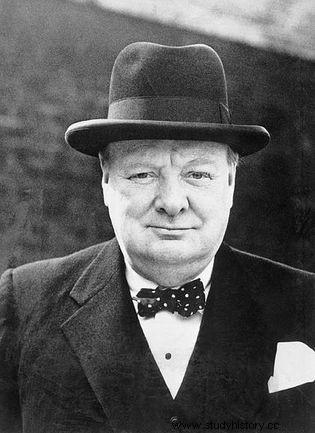
Winston Churchill couldn't let Malta fall into German hands.
Admiral Syphret's Armada
The Royal Navy, however, had no choice but to take risks. Especially that in the summer of 1942 the situation on the island was dramatic. The population was starving and the airframes stationed there were chronically short of planes and fuel. In this situation, a decision was made in London to organize Operation "Pedestal" - a daring rescue for Malta.
The entire project was planned with great flourish. In the convoy that left Clyde on August 3, 1942, there were 14 supply ships carrying food, fuel and weapons. Everything was protected by an armada of warships, commanded by Vice Admiral Edward Syfret.
It included the battleships "Nelson" and "Rodney", the aircraft carriers "Victorious", "Indomitable" and "Eagle", and the old aircraft carrier "Furious", which carried fighters to supply RAF squadrons in Malta.
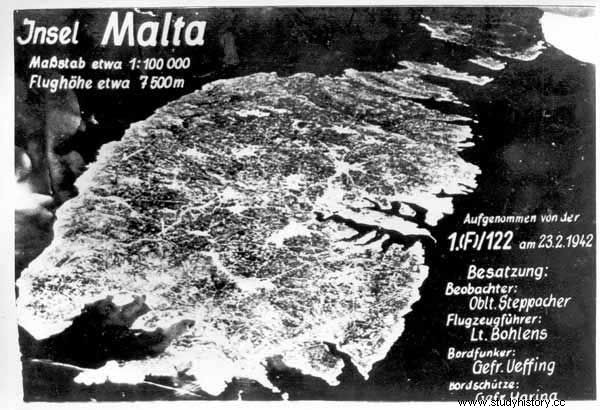
Malta. The Germans nearly starved the island. The efforts of the Royal Navy sailors thwarted these plans.
This, of course, is not all. In the cover of the convoy, there were also six cruisers, 24 destroyers, and a number of smaller units. Additionally, anti-aircraft weapons were installed on all transport ships. A true display of Britain's naval empire.
It would seem that the precautionary measures taken gave absolute certainty that the entire operation would be successful. None of these things. The Germans and Italians were not going to sit with their arms folded. Additionally, to the disadvantage of the British was the fact that in the western Mediterranean, the asdic warning system was not working efficiently.
Underwater currents resulting from the confluence of warm water with the cooler waters of the Atlantic were to blame. As a result, the convoy became an easy target for enemy submarines, which began their hunt on the afternoon of August 11.
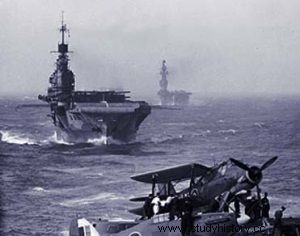
HMS Victorious and HMS Indomitable on their way to Malta. Even before the trouble started…
First Blood
The first victim of a German U-boat was the carrier "Eagel". It was hit by several U 73 torpedoes and sank after just eight minutes. 260 of the 1,160 crew members were killed in the attack. As one of the witnesses reported:
It was a terrible sight. The ship leaned to the side, then turned upside down and sank with terrible speed. When he fell over, dozens of people and planes fell from its deck (Quote from the book "And hell broke loose. The world at war 1939-1945").
In turn, the carrier "Furious" - after the spitfires he was carrying flew to Malta - detached from the convoy and set off on the return journey. However, the unit was targeted by the Italian submarine "Dagabur". Fortunately, it was spotted in time by the destroyer "Wolverine", which torpedoed the attacker, sending him to the bottom. The British destroyer was victorious, but also sustained severe damage itself, which excluded it from further fighting.
Meanwhile, at 8:45 pm, the Luftwaffe joined the game. Specifically, 36 Heinkeli He 111s and Junkers Ju 88s that flew in from Sicily. Thanks to the previous intensive anti-aircraft exercises, the convoy repulsed the attack without any losses of its own. We even managed to shoot down four enemy machines, but it was only a good bad start.
The Germans, irritated by this failure, the next day launched a much larger force against the British, in the form of 70 bombers and torpedo bombers. The raid began at noon and lasted for two hours. His victim was the freighter "Deucalion", which was badly damaged and - despite the heroic efforts of the crew - sank a few days later off the coast of Tunisia.
Submarines also did not allow themselves to be forgotten. In the afternoon of August 12, they launched another attack on the convoy. This time its cover did not come as a surprise, moreover, the destroyer "Ithuriel" managed to sink the Italian submarine "Cobalto", but there was no time to celebrate.
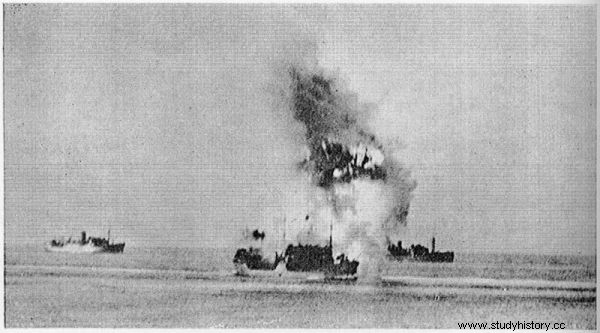
Ohio hit by a German torpedo. The slaughter in the Mediterranean begins.
In the evening, German and Italian planes returned. There were over a hundred of them and attacked from all possible directions and heights to confuse the convoy's defenses which has largely been successful. The Axis pilots managed to sink the destroyer "Foresight" and severely damage the carrier "Indomitable", which was hit by three bombs.
Massacre of the innocents
In this situation - although the convoy did not even reach the Strait of Messina - Vice Admiral Syfret decided to send the largest units west. Now the core of the convoy's cover was a group of six cruisers led by Vice Admiral Harold Burrough. This order ultimately determined the fate of the convoy and was almost tantamount to capitulation .
Only an hour after Syfret had left, the slaughter of the innocent had begun. After the Italians lost two units, it's time for a rematch. The crew of the submarine "Axum" achieved three brilliant successes in just a few minutes. In one attack, Italy succeeded in sending the anti-aircraft cruiser "Cairo" to the bottom and damaging Burrough's flagship cruiser "Nigeria", which had to turn back to Gibraltar. The "Ohio" tanker was also damaged .
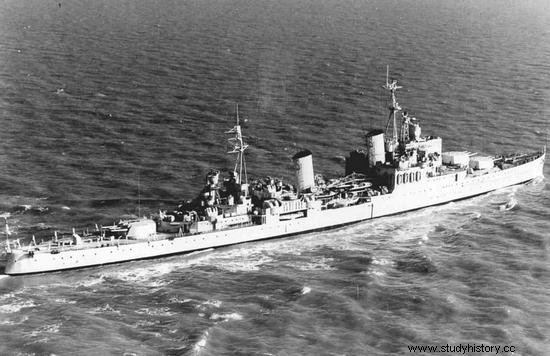
Flagship of Vice Admiral Burrough, cruiser HMS Nigeria. After it was damaged and the anti-aircraft cruiser HMS "Cairo" sank, the convoy lost contact with the base in Malta.
The losses were all the more painful as they caused the convoy to lose voice communication with the RAF base in Malta. This was because only "Nigeria" and "Cairo" had the necessary equipment on board.
The night of August 12-13 brought more casualties on the side of the British. Luftwaffe planes sank Empire Hope and Clan Ferguson and disabled Brisbane Star.
In addition, the submarine torpedoed the cruiser "Kenya", causing serious damage. Then German and Italian torpedo boats joined the action. In an attack that lasted several hours, it was completely damaged the cruiser "Manchester" (later sank) and one merchant ship remained, and four other transports sank.
As if that were not enough, Luftwaffe planes flew in again on the morning of August 13, sinking another merchant ship. The Ohio tanker sustained further damage but continued on until further attacks that occurred in the early afternoon stopped its engines . The other two transport units had a similar fate, so that they had to be left under the cover of destroyers.
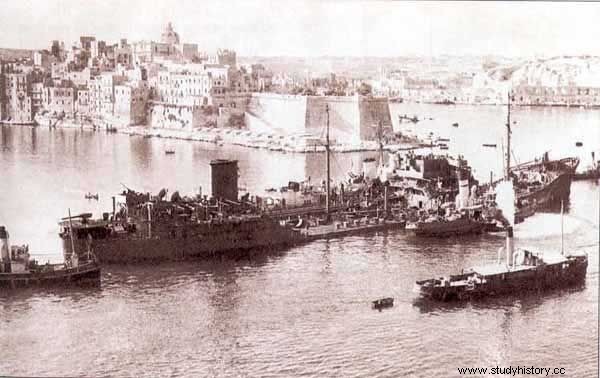
Only the remnants of a mighty armada have reached Malta.
Meanwhile, Burrougha and the three surviving cruisers set off towards Gibraltar at 4 p.m. There were only three ships left to the shores of Malta. At 6.00 p.m., Port Chalmers, Melbourne Star and Rochester Castle arrived at Grand Harbor, arriving at the very last moment, when the deck was already flooded with water. The crews were greeted warmly by the islanders.
Bitter balance
However, it was not yet the end of the tragedy of the convoy. The Germans - having no better goals - started to eliminate the marauders. The damaged Dorset went first. Another tanker "Ohio" was hit, which surprisingly still did not want to sink - probably thanks to the solid work of American shipbuilders - and was towed to the port in the morning of August 15.
For his heroic demeanor, the captain of the Dudley Mason unit was awarded the George Cross. The "Brisbane Star", damaged on the night of August 12-13, was also reached its destination.
In the end, Operation Pedestal was a Pyrrhic success at best. We managed to deliver 32,000 tons of material supplies, 12,000 tons of coal and a two-month supply of fuel to Malta.
The island was saved, but the price was incredibly high. One can speak about the defeat suffered by the Royal Navy. Nine of the fourteen transport ships sank, and the navy lost three cruisers, an aircraft carrier, and a destroyer. The aircraft carrier, the cruiser and two destroyers suffered serious damage. No wonder the sailors gave Operation Pedestal the code name "M". Like Murder.
Source:
This article is based on the book by Max Hastings entitled “And all hell broke loose. The world at war 1939-1945 ”(Wydawnictwo Literackie, 2013). All quotes in the text are from the book.
